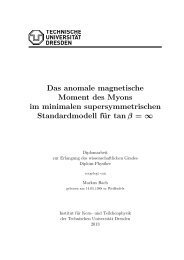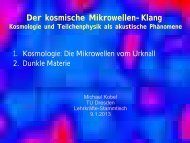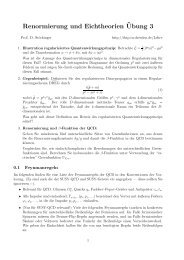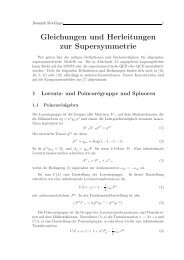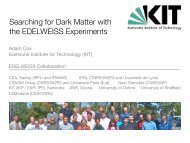a design study for a cobra upgrade to - Institut für Kern- und ...
a design study for a cobra upgrade to - Institut für Kern- und ...
a design study for a cobra upgrade to - Institut für Kern- und ...
Create successful ePaper yourself
Turn your PDF publications into a flip-book with our unique Google optimized e-Paper software.
44 4 Scintillation detec<strong>to</strong>rs<br />
AVALANCHE PHOTO DIODES (APDs) are diodes with an internal multiplication<br />
process. The small amount of charge, which is produced in<br />
conventional diodes, is increased with the avalanche effect. The charge<br />
carriers are accelerated sufficiently between collisions with the lattice<br />
<strong>to</strong> produce additional electron hole pairs. The gain is independent of<br />
the amount of incident light <strong>for</strong> applied voltages higher than the breakdown<br />
voltage. APDs are used with applied reverse voltage near below<br />
the breakdown voltage. There, the gain is proportional <strong>to</strong> the applied<br />
voltage. With a gain of a few h<strong>und</strong>red a signal is produced that is bigger<br />
than the electronic noise level. The quantum efficiency is 80 %. The<br />
signal level is very sensitive <strong>to</strong> temperature and the applied voltage.<br />
Statistical variations of the avalanche effect lead <strong>to</strong> considerable fluctuations<br />
in the multiplication process. These are larger than the fluctuations<br />
in the multiplication process of PMTs and can significantly contribute<br />
<strong>to</strong> the energy resolution. It becomes usually inferior <strong>to</strong> conventional<br />
silicon pho<strong>to</strong>diodes. A better energy resolution <strong>for</strong> lower particle<br />
energies, as can be achieved with conventional diodes, is nevertheless<br />
possible, because the noise level of the preamplifier is usually much<br />
higher than the noise level of diodes. The dark current depends on the<br />
diode size and is between 0.5 and 50 nA [29, 41].<br />
SI-PMT are pixelated avalanche diodes used in Geiger mode. This is<br />
the operation at break down voltage, where the gain is independent of<br />
the bias voltage. Si-PMT are with a gain of 10 5 <strong>to</strong> 10 6 competitive <strong>to</strong><br />
PMTs. The signal of a Si-PMT is the sum of each APD pixel output.<br />
Single pho<strong>to</strong>ns produce detectable charge avalanches. This allows the<br />
counting of single pho<strong>to</strong>ns or the detection of pulses of multiple pho<strong>to</strong>ns.<br />
Due <strong>to</strong> the limited pixel number, saturation occurs <strong>for</strong> high count<br />
rates. Room temperature operation is possible. They have good time<br />
resolution and can work in magnetic fields.<br />
4.2.2 Detec<strong>to</strong>r mounting<br />
Having a scintilla<strong>to</strong>r and an electronic readout device, the latter must<br />
be mounted on<strong>to</strong> the scintilla<strong>to</strong>r in a way that allows the detection of<br />
as much scintillation light as possible. Self-absorption and losses at the<br />
scintilla<strong>to</strong>r surfaces impede the collection of the entire produced scintillation<br />
light. The amount of self-absorption depends on the scintilla<strong>to</strong>r<br />
size and opacity. It becomes a non-negligible fac<strong>to</strong>r <strong>for</strong> scintilla<strong>to</strong>r<br />
length that is in the order of the attenuation length of the crystal. This<br />
can be, depending on the quality of the crystal, up <strong>to</strong> meters.





